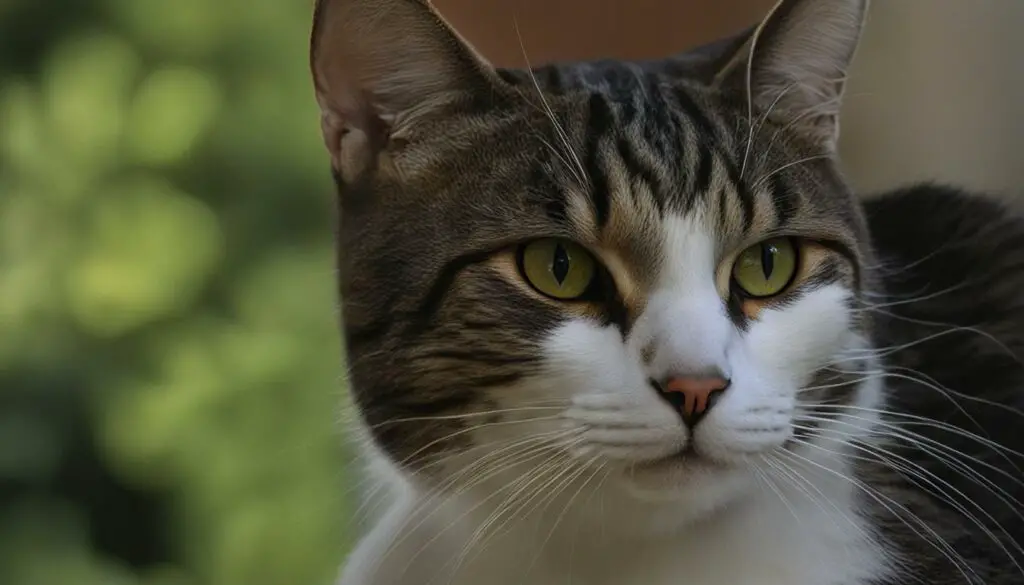If you notice hair loss on your cat’s head or around its ears, you may become concerned about the change. There are several reasons for a cat losing hair on ears, many of which you’ll be glad to hear are treatable with the right knowledge.
Key Takeaways:
- Cats can experience hair loss around their ears due to various reasons, including hereditary factors, acquired hair loss, and specific skin conditions.
- Possible causes for hair loss on a cat’s ears include mange, fleas, food allergies, chronic stress, ringworm, ear mites, and other skin conditions.
- Identifying the underlying cause is crucial for proper treatment and hair regrowth in cats.
- Treatment options may include topical ointments, medication, shampoos, and soothing products.
- Prevention through regular grooming, providing a balanced diet, and maintaining a stress-free environment can help prevent hair loss in cats.
Is It Normal for Cats to Lose Hair Around the Ears?
Many cat owners may wonder if it is normal for their furry companions to lose hair around their ears. The answer is not always straightforward, as it can depend on the underlying causes. While hereditary hair loss is not uncommon, acquired hair loss can be a concern. Acquired hair loss is often a result of irritants in the environment that lead to excessive scratching and hair loss.
If your cat is experiencing hair loss around the ears, it is important to understand the potential reasons behind it. Common causes include mange, fleas, food allergies, chronic stress, ringworm, ear mites, and various skin conditions. These conditions can cause itching, scratching, and self-inflicted hair loss, leading to bald spots in the front of the ears.
Is It Normal for Cats to Lose Hair Around the Ears?
When it comes to hereditary hair loss, it is not unusual for certain breeds to have bald spots in front of their ears. However, acquired hair loss should be assessed and addressed to prevent further discomfort for the cat. Identifying the specific cause of the hair loss is vital in determining the appropriate treatment plan.
Understanding the potential causes of hair loss around a cat’s ears can help owners take the necessary steps to provide relief and promote regrowth. Whether it’s managing parasites, addressing allergies, or creating a stress-free environment, taking action can restore your cat’s coat to its former glory.
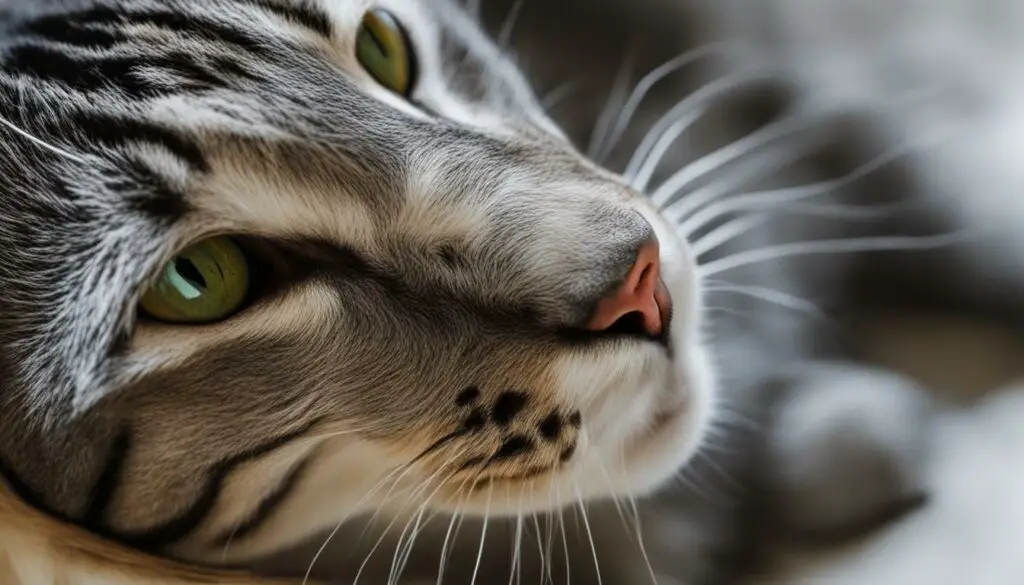
Possible Causes for Cats Losing Hair on Their Ears
| Cause | Symptoms |
|---|---|
| Mange | Severe itchiness, hair loss, skin inflammation |
| Fleas | Skin inflammation, irritation, excessive scratching |
| Food Allergy | Hair loss, skin irritation, allergic reactions |
| Chronic Stress | Excessive grooming, hair loss due to anxiety |
| Ringworm | Hair loss, circular patches, itchiness |
| Ear Mites | Severe itching, irritation, hair loss around the ears |
| Skin Conditions | Dry skin, scabs, dandruff, visible signs of irritation |
Identifying the cause of hair loss is crucial, as it will determine the appropriate treatment options. Whether it’s treating parasites, addressing allergies, or managing stress, restoring your cat’s coat health is possible with the right approach.
Possible Causes for Cats Losing Hair on Their Ears
If your cat is experiencing hair loss on its ears, there are several possible causes to consider. Understanding these causes can help you identify the underlying issue and seek appropriate treatment. Here are some potential reasons for hair loss around a cat’s ears:
Mange
Mange is a parasitic mite that burrows under the cat’s skin, causing itchiness and hair loss. It is highly contagious and can spread quickly if left untreated. Treatment options include topical ointments, lime sulfur dips, and anti-inflammatory medications.
Fleas
Fleas can cause skin inflammation and irritation, leading to hair loss, particularly around the ears. Flea saliva is highly irritating to cats. Identifying and treating fleas, as well as using hypoallergenic shampoos and flea preventatives, can help alleviate the problem.
Food Allergy
Hair loss can be a result of a food allergy, even if the cat has been eating the same food for a long time. Allergic reactions can cause hair loss and skin irritation. Identifying and eliminating the allergen from the cat’s diet can help resolve the issue.
Chronic Stress
Cats experiencing prolonged stress or anxiety may engage in excessive grooming, leading to hair loss. Managing the cat’s environment and providing stress-relief techniques, such as interactive toys and calming techniques, can help reduce stress-related hair loss.
Ringworm
Ringworm is a fungal infection that can cause hair loss around the ears. It is highly contagious and can spread easily among cats. Treatment options include antifungal shampoos and medications.
Ear Mites
Ear mites can cause severe itching and hair loss around the ears. This condition is contagious and can be passed between cats. Treatment involves addressing the ear mite infestation and soothing the irritated skin.
Skin Conditions Related to Hair Loss
Various skin conditions can contribute to hair loss in cats. Severe cat acne, dermatitis, and other allergies can cause hair loss and skin irritation. Identifying the underlying skin condition and treating it appropriately can help resolve the hair loss issue.
By understanding the potential causes of hair loss on a cat’s ears, you can take the necessary steps to address the issue and restore your cat’s healthy coat.
Mange
Mange is a parasitic mite that burrows under the cat’s skin, causing itchiness and hair loss. It is a contagious condition that can spread quickly if left untreated. The most common type of mange in cats is caused by the mite species Felis scabiei. Infected cats experience intense itching and may scratch excessively, leading to the formation of crusts and scabs on the skin.
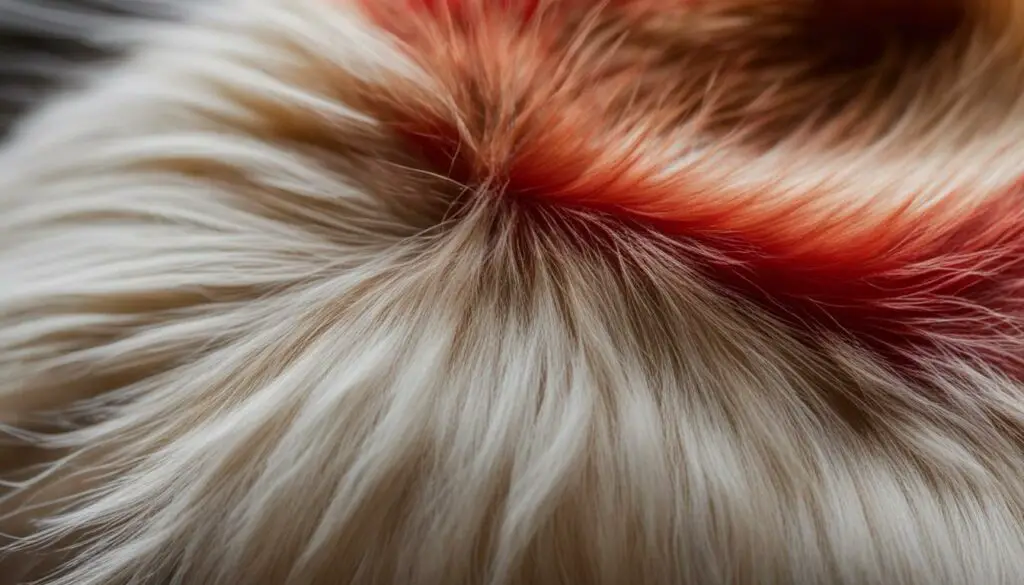
There are several treatment options available for mange in cats. Topical ointments containing insecticides or acaricides can be applied directly to the affected areas to kill the mites. Lime sulfur dips are also effective in treating mange and can be used as a form of therapy for the cat’s entire body. Additionally, anti-inflammatory medications may be prescribed to alleviate itching and reduce inflammation.
It’s important to consult a veterinarian for a proper diagnosis and treatment plan for your cat’s mange. They will be able to recommend the most suitable treatment options based on the severity of the infestation and your cat’s overall health.
Section 5: Fleas
If you notice hair loss around your cat’s ears, fleas could be the culprit. These small parasitic insects can cause irritation and inflammation of the skin, leading to excessive scratching and hair loss. Flea saliva contains substances that can trigger an allergic reaction in cats, making them more susceptible to hair loss in specific areas, including around the ears.
Preventing and treating fleas is essential for maintaining your cat’s skin health and preventing further hair loss. Regularly checking your cat for fleas and using effective flea preventatives can help keep these pesky pests at bay. Additionally, using hypoallergenic shampoos specifically formulated for cats can help soothe irritated skin and reduce the likelihood of hair loss.
If your cat already has fleas, it’s important to address the infestation promptly. Consult with your veterinarian to determine the best course of treatment, which may include topical flea medications, oral medications, or other flea control products. By eliminating fleas and providing relief for your cat’s irritated skin, you can promote hair regrowth and restore your cat’s coat to its full glory.

| Flea Treatment Options | Effectiveness | Application Method |
|---|---|---|
| Topical flea medications | Highly effective | Applied directly to the skin, usually between the shoulder blades |
| Oral flea medications | Highly effective | Administered orally, often in the form of chewable tablets |
| Flea collars | Varies depending on brand | Worn around the neck, releasing active ingredients to repel and kill fleas |
| Flea shampoos | Temporary relief | Used during a bath to kill and remove fleas from the coat |
| Flea sprays | Temporary relief | Applied directly to the coat to kill and repel fleas |
Food Allergy
Food allergies can be a surprising cause of hair loss in cats, even if they have been eating the same food for a long time. Just like humans, cats can develop allergies to certain ingredients in their diet. These allergies can lead to skin irritation and hair loss. It’s important to note that food allergies are different from food intolerances, which may cause gastrointestinal symptoms instead of skin issues.
When a cat has a food allergy, its immune system overreacts to a specific ingredient, triggering an allergic reaction. Common allergens for cats include beef, fish, dairy, and grains. Recognizing the signs of a food allergy can help in identifying the problem. In addition to hair loss, other symptoms may include itchiness, redness, swelling, and gastrointestinal problems.
If you suspect a food allergy is causing your cat’s hair loss, it’s important to consult a veterinarian who can help determine the allergen through an elimination diet or blood tests. Once the allergen is identified, the veterinarian will recommend switching to a hypoallergenic diet that avoids the problematic ingredient. Over time, with the elimination of the allergen from the cat’s diet, the hair loss should diminish, and the cat’s skin will heal.
| Signs of Food Allergy in Cats | Treatment Options |
|---|---|
|
|
It’s important to note that hair regrowth may take time and vary depending on the severity of the allergy and the cat’s individual response. Patience and consistency in following the veterinarian’s advice are key to resolving the issue. In some cases, additional treatments such as omega-3 fatty acid supplements or medications to relieve symptoms may be recommended to support the healing process.

Chronic Stress and Hair Loss in Cats
Chronic stress can have a significant impact on cats, and one of the visible effects is hair loss. Cats experiencing prolonged stress or anxiety may engage in excessive grooming, leading to hair loss, particularly around the ears. This behavior is known as psychogenic alopecia. It is important to address the underlying cause of stress to alleviate the hair loss and improve the cat’s well-being.
Managing a cat’s environment is crucial in reducing stress-related hair loss. Creating a calm and peaceful space for your feline friend can help alleviate anxiety. Providing interactive toys, vertical spaces, and hiding spots can also help reduce stress levels. Additionally, incorporating calming techniques such as pheromone diffusers or herbal remedies might provide relief for stressed cats.
Regular playtime and positive reinforcement training can also contribute to reducing stress. Playing with your cat helps release pent-up energy and provides mental stimulation. Bonding through play and rewarding good behavior can help strengthen the owner-cat relationship and promote a sense of security and comfort.
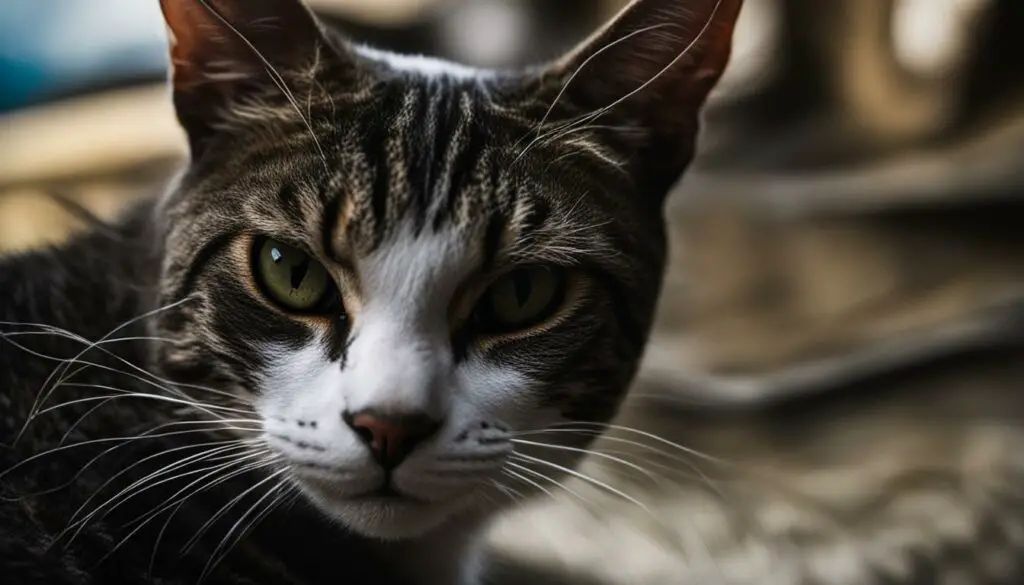
Recognizing signs of chronic stress in cats
Excessive grooming, avoiding interactions, changes in appetite, hiding, aggression, and inappropriate elimination are among the signs that indicate a cat is experiencing chronic stress.
Understanding and addressing chronic stress in cats is essential to prevent and manage hair loss. By creating a stress-free environment, providing mental stimulation, and seeking professional guidance when needed, we can help our feline companions lead happy and healthy lives.
Ringworm: A Fungal Infection Causing Hair Loss in Cats
If you notice your cat experiencing hair loss around the ears, one possible cause could be ringworm, a common fungal infection. Ringworm, despite its name, is not caused by a worm but rather a contagious fungus that can be easily spread among cats. This condition can result in itchiness, redness, and patchy hair loss.
To better understand the impact of ringworm on cats, let’s take a closer look at the symptoms, treatment options, and preventive measures to keep your feline friend healthy and free from this pesky infection.
Symptoms of Ringworm in Cats
Ringworm in cats typically presents as circular patches of hair loss, which may appear crusty or scaly on the skin. The affected areas may also be accompanied by redness, inflammation, and itchiness. It’s important to note that while ringworm can occur on any part of the body, it is commonly found around the ears in cats.
In some cases, cats with ringworm may not show any symptoms, making it essential to regularly monitor your pet’s fur and skin for any changes or signs of irritation. If you suspect ringworm or notice any unusual skin changes, it’s best to consult a veterinarian for proper diagnosis and treatment.
Treatment and Prevention of Ringworm
When it comes to treating ringworm in cats, a comprehensive approach is necessary to effectively eliminate the fungal infection. Treatment options commonly include antifungal shampoos, topical creams, and oral medications. Your veterinarian may also recommend isolating the infected cat to prevent the spread of ringworm to other pets or family members.
Preventing ringworm involves maintaining good hygiene and minimizing exposure to infected animals or environments. Regularly cleaning your cat’s living spaces, bedding, and grooming tools can help reduce the risk of fungal contamination. Additionally, promoting a healthy immune system through a balanced diet and regular veterinary check-ups can assist in preventing and managing ringworm infections.
By being vigilant and seeking appropriate treatment, you can help your cat recover from ringworm and prevent future occurrences. Remember to consult your veterinarian for personalized advice based on your cat’s specific needs and circumstances.
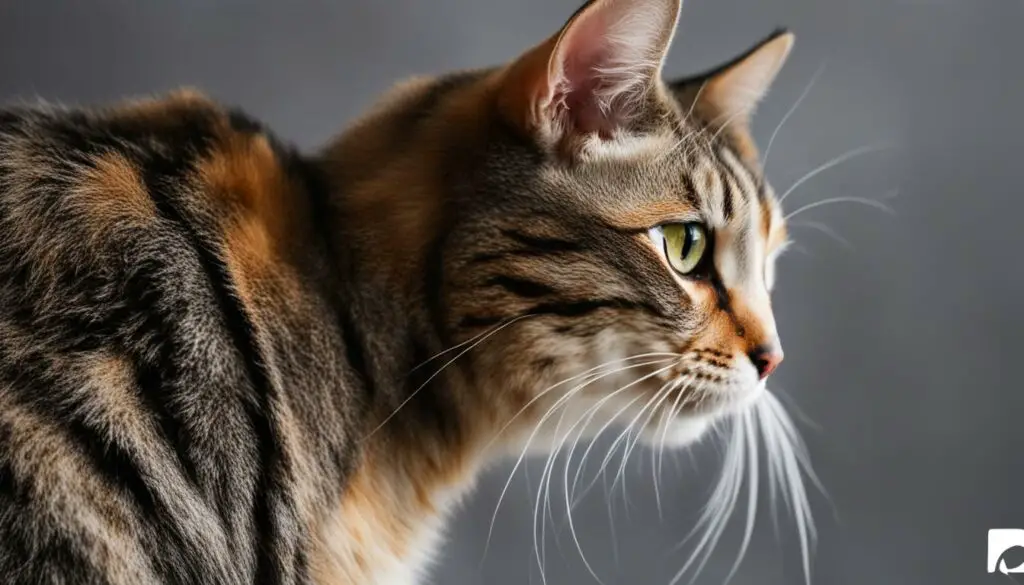
Ear Mites and Hair Loss in Cats
If you notice your cat experiencing hair loss around the ears, it could be due to a common condition known as ear mites. Ear mites are tiny parasitic insects that infest the ear canal and surrounding areas, causing severe itching and discomfort. As a result, cats may scratch excessively, leading to hair loss and skin irritation.
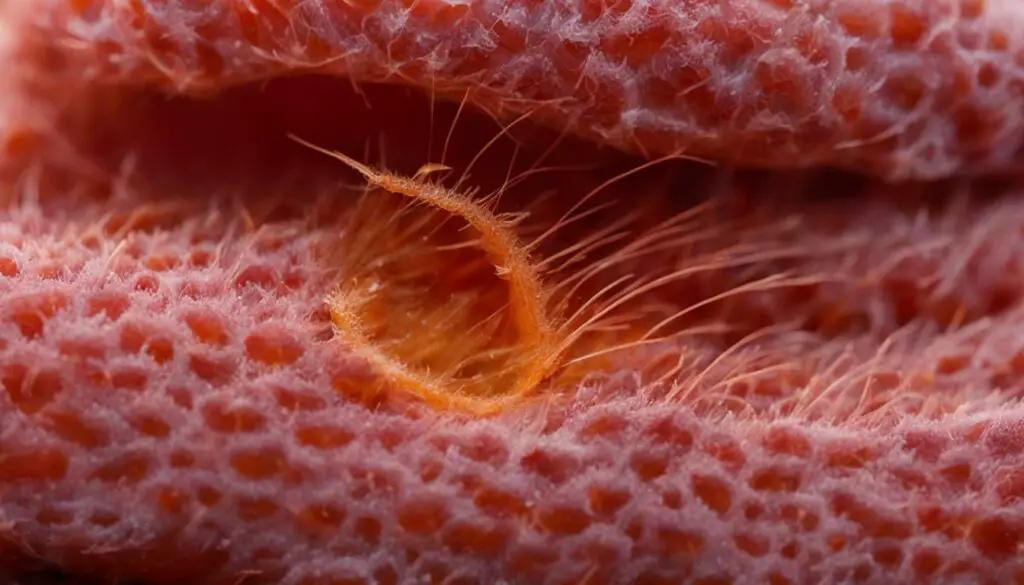
Ear mites are highly contagious and can easily spread from one cat to another through close contact. If you suspect your cat has ear mites, it is essential to seek veterinary treatment to eliminate the infestation and provide relief for your furry friend.
“Ear mites can cause severe itching and hair loss around the ears.”
Signs of Ear Mites in Cats
Recognizing the signs of ear mites in cats is crucial for early detection and intervention. Common symptoms include:
- Excessive scratching of the ears
- Shaking their head frequently
- Dark discharge or debris in the ears
- Inflammation and redness around the ears
If you observe any of these signs, it is important to consult your veterinarian for a proper diagnosis and treatment plan. Early intervention can prevent the spread of ear mites and minimize the impact on your cat’s health.
Treatment for Ear Mites
Treating ear mites typically involves a combination of thorough cleaning and medication. Your veterinarian may prescribe ear drops or topical creams to eliminate the mites and soothe the irritated skin. Additionally, they may recommend regular ear cleanings to remove debris and prevent future infestations.
“Recognizing the signs of ear mites in cats is crucial for early detection and intervention.”
During treatment, it is important to follow your veterinarian’s instructions carefully. Be sure to complete the full course of medication, even if the symptoms improve. Regular follow-up appointments can help monitor your cat’s progress and ensure the infestation is fully resolved.
Preventing Ear Mites
Preventing ear mites in cats involves maintaining good overall hygiene and minimizing exposure to infested animals. Regularly cleaning your cat’s ears and keeping them free from excessive wax and debris can help create an unfavorable environment for mites. Additionally, avoiding contact with stray or untreated cats can reduce the risk of infestation.
If you suspect that your cat has been exposed to ear mites, it is important to isolate them from other pets until they have been treated and cleared by a veterinarian. This can help prevent the spread of mites to other animals in your household.
| Key Points | Benefits |
|---|---|
| Treat ear mites promptly | Prevent discomfort and hair loss |
| Recognize the signs | Early intervention and treatment |
| Follow veterinarian’s instructions | Effective elimination of mites |
| Maintain good hygiene | Prevent future infestations |
Skin Conditions Related To Hair Loss
When it comes to hair loss in cats, there are various skin conditions that can contribute to this problem. These conditions can cause hair loss and skin irritation, impacting the overall health and well-being of your feline friend.
Some common skin conditions that can lead to hair loss in cats include severe cat acne, dermatitis, and allergies. These conditions can cause itching, inflammation, and other discomforts for your cat, resulting in self-inflicted hair loss.
Identifying the underlying skin condition is crucial in determining the appropriate treatment for your cat. It’s essential to consult with a veterinarian who can provide a proper diagnosis and recommend an effective treatment plan to address the specific skin condition causing the hair loss.
| Skin Condition | Symptoms | Treatment |
|---|---|---|
| Severe Cat Acne | Blackheads, pimples, swelling | Topical ointments, antibacterial washes |
| Dermatitis | Redness, itching, inflamed skin | Antibiotic creams, corticosteroids |
| Allergies | Itching, scratching, hives | Identify and eliminate allergen, antihistamines |
By addressing the underlying skin condition and providing appropriate treatment, you can help alleviate the discomfort and promote hair regrowth in your cat. It’s essential to follow the veterinarian’s instructions and monitor your cat’s progress to ensure a successful recovery.
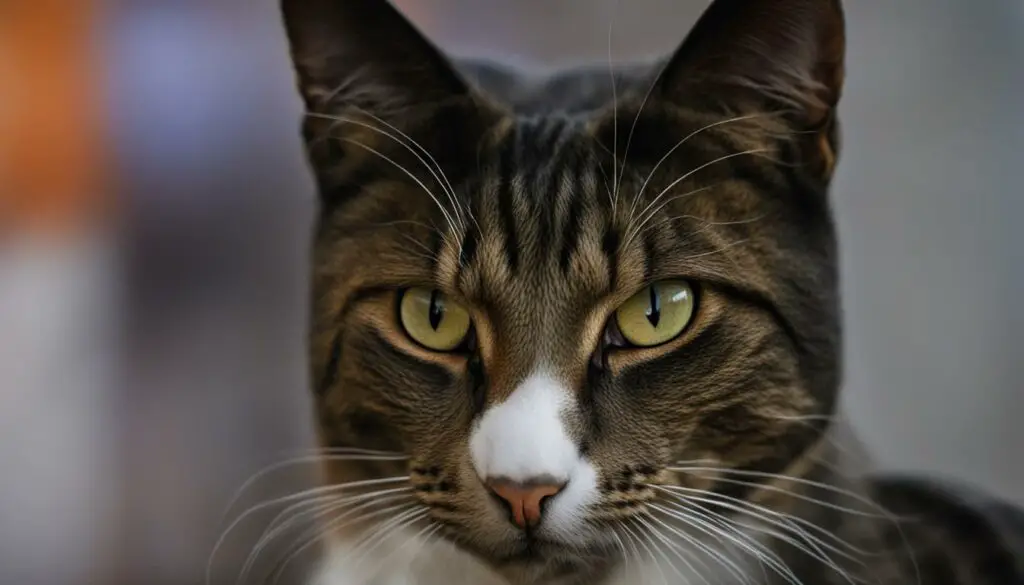
Common Signs of Skin Conditions in Cats
As a cat owner, it’s important to be aware of common signs that may indicate the presence of skin conditions in your feline companion. Look out for the following symptoms, which could suggest that your cat is experiencing a skin issue:
- Head shaking: Excessive shaking of the head could indicate irritation or discomfort in the ears or on the head.
- Excessive licking and scratching: If your cat is constantly licking or scratching a particular area, it may be a sign of itching or irritation.
- Dry skin: Dry and flaky skin can be a sign of underlying skin conditions, such as dermatitis.
- Dull fur: A lackluster coat could indicate poor skin health or an ongoing skin problem.
- Scabs: The presence of scabs on the skin may suggest that your cat is experiencing inflammation or infection.
- Dandruff: Flakes of dandruff in your cat’s fur might signal dry and irritated skin.
- Visible signs of irritation: Redness, swelling, or sores on the skin are key indicators of a skin condition that requires attention.
If you notice any of these signs in your cat, it is essential to consult with a veterinarian for a proper diagnosis and treatment plan. Skin conditions can be uncomfortable and even painful for your furry friend, so addressing them promptly is crucial for their overall well-being.
Remember, cats are experts at hiding discomfort, so it’s essential to pay attention to subtle changes in behavior or appearance. Regular grooming sessions and close examination of the skin can also help you detect potential issues early on, allowing for timely intervention and treatment.
By being vigilant and knowledgeable about the common signs of skin conditions in cats, you can ensure that your feline companion receives the care and support they need to maintain healthy skin and a vibrant coat.
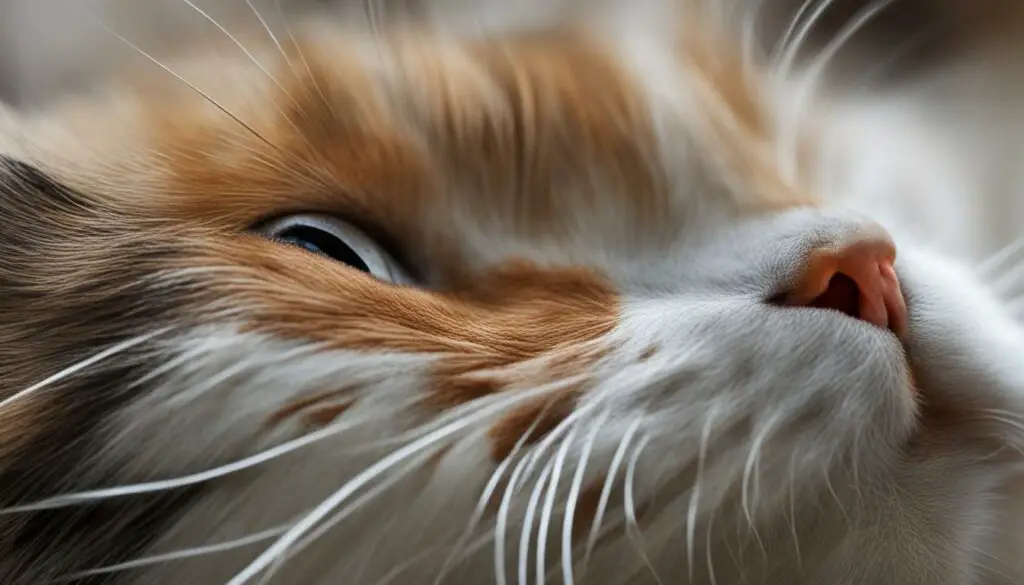
Finding The Problem
When your cat experiences hair loss around the ears, it’s essential to find the underlying problem to provide the appropriate treatment. One way to identify potential issues is by giving your cat’s coat a thorough comb-through. By separating the fur and examining the skin closely, you may reveal signs of inflammation or other problems.
Bathing your cat with soothing products can provide relief and allow for better investigation of the problem areas. Pay attention to any areas of irritation or hair loss during the bathing process. If you notice any abnormalities or suspect a skin condition, it’s best to consult with a veterinarian for a proper diagnosis and treatment plan.
Table: Common Causes of Hair Loss in Cats
| Cause | Description |
|---|---|
| Mange | A parasitic mite that burrows under the cat’s skin, causing itchiness and hair loss. |
| Fleas | Can cause skin inflammation and irritation, leading to hair loss, particularly around the ears. |
| Food Allergy | Allergic reactions to certain foods can cause hair loss and skin irritation. |
| Chronic Stress | Excessive grooming due to prolonged stress or anxiety can result in hair loss. |
| Ringworm | A fungal infection that can cause hair loss around the ears. |
| Ear Mites | Infestation of mites in the ears can cause severe itching and hair loss. |
| Skin Conditions | Various skin conditions such as cat acne, dermatitis, and allergies can contribute to hair loss. |
By understanding the common causes of hair loss in cats, you can narrow down the possibilities and work towards finding the specific problem affecting your cat. Identifying the underlying issue is crucial for developing an effective treatment plan and promoting hair regrowth. Remember to always consult with your veterinarian for professional guidance and assistance in resolving your cat’s hair loss concerns.
Treatment Options
When it comes to treating hair loss in cats, there are several options available depending on the underlying cause. It is essential to consult a veterinarian for proper diagnosis and treatment recommendations. Here are some common treatment options for cat hair loss:
- Topical ointments: Medicated creams or ointments can help alleviate itching, reduce inflammation, and promote healing of the affected area.
- Antibiotic creams: In cases where the hair loss is due to infection, antibiotic creams may be prescribed to address the underlying bacterial cause.
- Antifungal shampoos: If the hair loss is caused by a fungal infection, such as ringworm, using antifungal shampoos can help eliminate the infection and promote hair regrowth.
- CBD products: Some cat owners have found success in using CBD products to alleviate itching and reduce inflammation associated with hair loss. However, it is important to consult with a veterinarian before using any CBD products on your cat.
Each treatment option should be used under the guidance of a veterinarian to ensure the safety and effectiveness of the treatment. It is crucial to follow the recommended dosage and application instructions provided by the veterinarian.

Further Treatment Considerations
In some cases, the underlying cause of the hair loss may require additional treatment methods. For example, if the hair loss is due to fleas, it is important to address the flea infestation in the cat’s environment to prevent re-infestation. Treating the cat’s bedding, vacuuming the house thoroughly, and using appropriate flea preventatives can help eliminate fleas.
In severe cases of hair loss or when the underlying cause is more complex, the veterinarian may recommend additional therapies, such as oral medications, corticosteroids, or allergy shots, to address the specific condition and promote hair regrowth.
It is important to be patient during the treatment process, as hair regrowth may take time. With proper treatment, care, and a stress-free environment, cats can often experience hair regrowth within a week to ten days. Regular follow-ups with the veterinarian will help monitor the progress and adjust the treatment plan if necessary.
Will the Hair Grow Back?
One of the primary concerns when a cat experiences hair loss, particularly in the areas around the ears, is whether the hair will grow back. The good news is that in most cases, with proper treatment and care, hair regrowth can be expected. Within a week to ten days of initiating treatment, you should start to see new hair growth.
It’s important to note that the time frame for hair regrowth may vary depending on the underlying cause of the hair loss. For example, if the hair loss is due to a mild skin irritation or allergy, the hair may regrow relatively quickly. However, if the hair loss is a result of a more severe condition, such as mange or ringworm, it may take longer for the hair to fully regrow.
To facilitate hair regrowth, it’s crucial to continue the recommended treatment for the underlying condition. This may include using topical ointments, antibiotic creams, antifungal shampoos, or other prescribed medications. Additionally, maintaining a healthy and stress-free environment for your cat can promote hair regrowth. Providing a balanced diet, regular grooming, and engaging in stress-relief techniques can all contribute to a happy and healthy cat with a full coat of fur.
Remember, if you’re concerned about your cat’s hair loss or if you notice any unusual symptoms, it’s always best to consult with a veterinarian. They can provide a proper diagnosis and recommend the most effective treatment plan to help your cat’s hair grow back and restore their overall well-being.
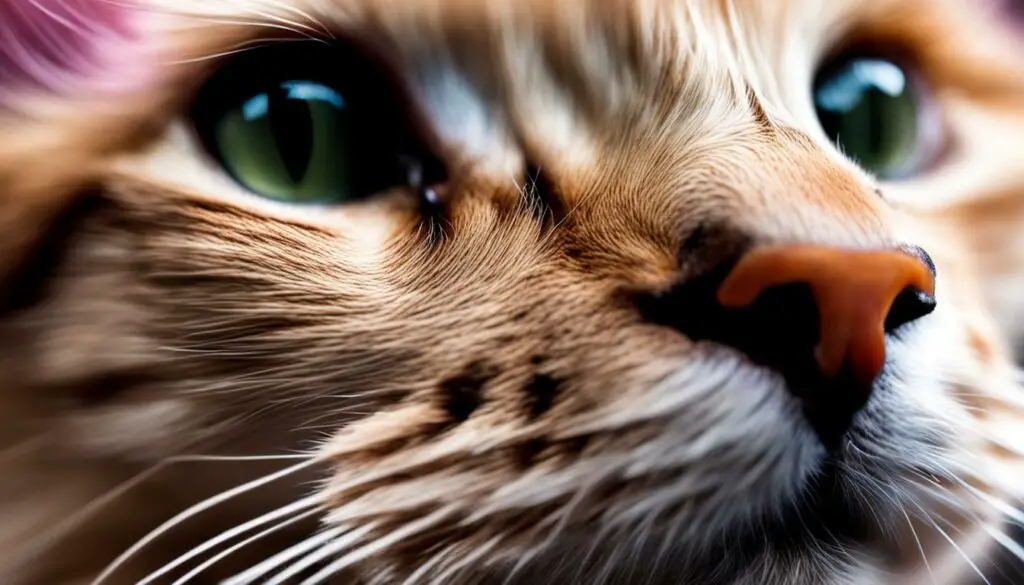
Prevention Tips
When it comes to preventing hair loss in cats, there are several measures you can take to ensure your feline friend maintains a healthy coat. By following these prevention tips, you can reduce the risk of hair loss and keep your cat’s skin in optimal condition.
Maintain a Clean Environment
A clean environment plays a crucial role in preventing skin issues and hair loss in cats. Regularly clean your cat’s living area, including their bedding and toys, to minimize the presence of irritants and allergens. Vacuuming your home regularly can also help remove any potential triggers that may cause skin irritation.
Provide a Balanced Diet
A well-balanced diet is essential for maintaining healthy skin and coat in cats. Ensure your cat’s food contains all the necessary nutrients, including essential fatty acids, vitamins, and minerals. Consult with your veterinarian to determine the best diet for your cat’s specific needs and consider incorporating omega-3 fatty acid supplements to promote a healthy coat.
Regular Grooming
Grooming your cat regularly not only helps keep their coat clean and tangle-free but also provides an opportunity to identify any potential skin issues early on. Brushing your cat’s fur removes loose hair and stimulates blood circulation, promoting a healthy coat. Additionally, regular grooming allows you to check for any signs of irritation, parasites, or abnormal hair loss.
Avoid Known Allergens
If your cat has known allergies, it’s important to identify and avoid the allergens that trigger their symptoms. Common allergens for cats include certain types of food, pollen, dust mites, and cleaning products. By eliminating exposure to these allergens, you can help prevent allergic reactions that may lead to hair loss.
By following these prevention tips, you can create a healthy environment for your cat and minimize the risk of hair loss. However, if you notice any signs of hair loss or skin irritation, it’s important to consult with a veterinarian for proper diagnosis and treatment.
Conclusion
As a cat owner, it’s important to understand why your furry friend may have bald spots in front of their ears. Hair loss in cats can be caused by a variety of factors, including hereditary issues, irritants in the environment, and various skin conditions. The good news is that many of these causes are treatable, and with the right knowledge and care, hair regrowth is possible.
To address hair loss in cats, it’s crucial to identify the underlying cause. This can be done by closely examining the affected areas, separating the fur, and looking for signs of inflammation or irritation. Consulting with a veterinarian is recommended for proper diagnosis and treatment options.
Prevention is also key in maintaining a healthy coat and reducing the risk of hair loss. Providing a clean environment, a balanced diet, and regular grooming can help prevent skin issues. Additionally, avoiding known allergens and using preventive measures, such as CBD products, can promote healthy skin and coat.
Remember, hair loss in cats is treatable, and with the right care, hair regrowth can be expected. By addressing the underlying cause, following proper treatment recommendations, and maintaining a stress-free environment, you can help your feline friend get back their luscious coat and ensure their overall well-being.
FAQ
Why do cats have bald spots in front of their ears?
Cats can have bald spots in front of their ears for various reasons, including mange, fleas, food allergies, chronic stress, ringworm, ear mites, and skin conditions.
Is it normal for cats to lose hair around the ears?
While some hair loss can be normal for cats, excessive hair loss around the ears may indicate an underlying issue that needs to be addressed.
What are possible causes for cats losing hair on their ears?
Possible causes include mange, fleas, food allergies, chronic stress, ringworm, ear mites, and various skin conditions.
What is mange?
Mange is a parasitic mite that burrows under the cat’s skin, causing itchiness and hair loss.
How do fleas contribute to hair loss in cats?
Fleas can cause skin inflammation and irritation, leading to hair loss, particularly around the ears.
Can food allergies cause hair loss in cats?
Yes, food allergies can cause hair loss and skin irritation in cats.
Can chronic stress lead to hair loss in cats?
Yes, cats experiencing prolonged stress or anxiety may engage in excessive grooming, leading to hair loss.
What is ringworm?
Ringworm is a fungal infection that can cause hair loss around the ears in cats.
How do ear mites cause hair loss?
Ear mites can cause severe itching and hair loss around the ears in cats.
What are some common skin conditions related to hair loss in cats?
Common skin conditions include cat acne, dermatitis, and various allergies.
What are the signs of skin conditions in cats?
Signs include head shaking, excessive licking and scratching, dry skin, dull fur, scabs, dandruff, and other visible signs of irritation.
How can I find the problem if my cat has hair loss?
Giving your cat’s coat a thorough comb-through, separating the fur, and examining the skin closely can help identify areas of irritation and potential hair loss.
What are the treatment options for cat hair loss?
Treatment options vary depending on the underlying cause and may include topical ointments, antibiotic creams, antifungal shampoos, and CBD products.
Will the hair grow back?
In most cases, with proper treatment and care, hair should start regrowing within a week to ten days.
What are some prevention tips for hair loss in cats?
Maintaining a clean environment, providing a balanced diet, regular grooming, avoiding known allergens, and using preventive measures like CBD products can help prevent hair loss in cats.

